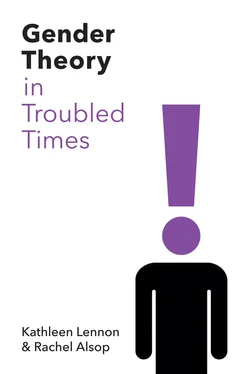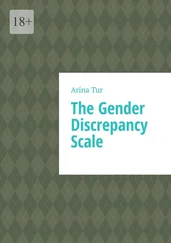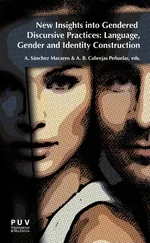In chapter 4we turn to the ground-breaking work of Simone de Beauvoir. In her 1949 text The Second Sex , Beauvoir weaves together the different strands of theory we have so far introduced. We foreground her work both for the key theoretical resources she provides, particularly from phenomenology, and for the exemplary way in which she makes clear how multiple factors are entangled in the account we offer of becoming gendered. She recognizes that we are assigned sexed positionality most commonly on the basis of biological features. But the consequences of such assignment depend on the (variable) meaning and significance attached to these categories, including what Beauvoir calls the social myths , what we would call the imaginaries, attached to men and women. It also depends heavily on the economic and legal structures within which we are placed. But Beauvoir adds another element to the discussion of becoming woman . She links the above factors, what she terms the objective conditions, to an account of gendered subjectivity, by attending to the lived experiences of women (and occasionally men) at different stages of their lives. These experiences are a consequence not only of being positioned within certain external structures but also of a process of internalizing the meaning and norms attached to this sexed positionality. Moreover, such internalization also contributes to the maintenance and reproduction of the objective inequalities.
In chapter 5we turn our attention to what is regarded as one of the key cornerstones of contemporary gender theory, namely the discussion of intersectionality. As signalled at the end of chapter 3, the work of second-wave and earlier black feminist theorists identified that the consequences of our gendered positionality varied according to our raced, cultural, national and other social positionalities. Other writers also made evident differences concerning sexuality and bodily abilities. We therefore need to consider how these different categories relate to each other. The discussion here looks at the intersection in terms of the objective structuring of the social world but also, following the lead of Beauvoir, in relation to the lived subjectivity of individuals within that world and the kind of intersectional identifications which constitute our sense of self. This discussion of intersectionality is also informed by the contributions of decolonial writers interrogating the application of Western gendered terms within the colonial encounter. The outcome of these discussions is a rejection of any universal accounts of the contents of gendered categories.
Next, in chapter 6, we turn to the work of Judith Butler. The publication of Butler’s Gender Trouble in 1990 and the articulation of her performative theory of gender changed the face of gender theory. It offered the most radical challenge thus far to gender essentialism in any form. Butler gave an account of the production of individual gendered identities, the social meanings of gender, and differing material outcomes in terms of performative acts. These acts were in accordance with socially given, gendered scripts, whose meanings the acts both reflected and helped constitute. Butler importantly recognized the interweaving of norms of gender and norms of sexuality, so that the gender binary itself was a requirement of a heterosexual model of sexuality and the family. But the meanings of our gendered categories and categories of sexuality, she stressed, are intersectional, unstable and shifting. Crucially, the meanings and the existence of the gender and sexual binaries themselves can be destabilized in unpredictable ways by the workings of performativity itself. We attempt to take on board the key insights of Butler’s account while also stressing the constraints of our bodies and of economic and social structures, which were given scant attention in her earlier work. In addition, central to our account here is the attention she gives, in later work, to our vulnerability to others , and to social practices, in making sense of ourselves. She stresses the need each of us has for recognition by others if we are to make sense of ourselves, and if we are to be able to live a life alongside them.
The key role of our gendered categories in making sense of ourselves, and negotiating a public space in which we can live alongside others, is the focus of our final chapter. Here our primary resources are trans theorists who engage with the lives of those who are in different ways gender non-conformist, some of whom may change their original gendered assignment. The variety of meaning and contextual specificity attached to our gendered terms, particularly as they intersect with categories of sexuality, is marked here. It reinforces our central claim that there are no sets of necessary and sufficient conditions determining what is required to be a woman or man. But there is something else which becomes clear here and which is central to our approach. There is nothing arbitrary or whimsical about the categories in terms of which we make sense of ourselves or others. Moreover, the appropriateness of any categorization is not simply a matter of subjective feelings (though these are important). Our gendered terms are public categories whose shifting usage has to make sense to a community of users as tools to negotiate liveable patterns of intersubjective relations, in both intimate and public spheres.
We hope the approach to gender articulated in this book will widen the communities in which shifting conceptions of gender, and the increasing fluidity of the boundaries, can find recognition.
1 See, for example, posts at www.facebook.com/womansplaceuk/and www.facebook.com/DRradfem/. 2 The paedophilia claim seems quite bizarre but is found in other places, including Poland. The accusation works via a focus on education. The encouragement of gender equality and diversity in schools is seen as promoting the sexualization of children and thereby their vulnerability to assault. This is a train of thought which is damaging on very many levels. It was put forward by some Catholic bishops, following the revelation of widespread abuse over decades within the church, in order to divert attention and find another scapegoat. Though, of course, gender theory did not exist and certainly was not taught during these decades of abuse. Rather, its advent encourages children to speak out. Then, obviously, the accusation has no grasp on the means by which children become inappropriately sexualized. And, worst of all, it blames supposedly sexualized children for their own assault. 3 See the references given in note 1 above.
We … often behave and talk as if the sexes are categorically different: men like this , women like that . … In toy stores sex-segregated product aisles … assume that a child’s biological sex is a good guide to what kinds of toys will interest them. … When we think of men and women in this complementary way it is intuitive to look for a single powerful cause that creates the divide between the sexes. … Wouldn’t it make sense if testosterone … makes men like this , while its minimal presence in females helps to make women like that ? … This is Testosterone Rex: that familiar, pervasive and powerful story of sex and society. Weaving together interlinked claims about evolution, brains, hormones and behavior, it offers a neat and compelling account … [But] Testosterone Rex is wrong, wrong, and wrong again. (Fine 2017: 17–22)
The idea of the male brain and the female brain suggests that each is a characteristically homogenous thing and that whoever has got a male brain, say, will have the same kind of aptitudes, preferences and personalities as everyone else with that ‘type’ of brain. We now know that is not the case. We are at the point where we need to say, ‘Forget the male and female brain; it’s a distraction, it’s inaccurate.’ … It is now a scientific given … that the brain is moulded from birth onwards and continues to be moulded through to the ‘cognitive cliff’ in old age when our grey cells start disappearing. So out goes the old ‘biology is destiny’ argument. (Gina Rippon, quoted in Fox 2019)
Читать дальше












